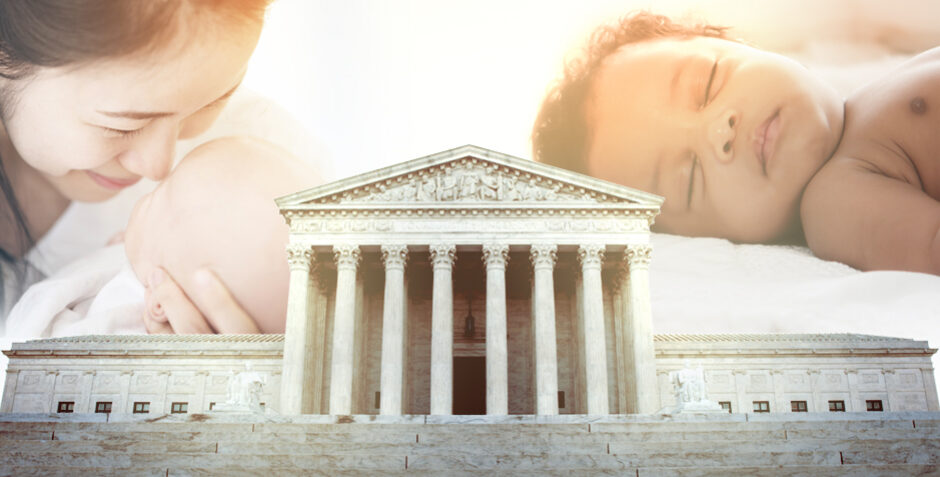ACLJ Dismantles the Legal Fallacies of Roe v. Wade in Three Supreme Court Briefs
The American Center for Law and Justice (ACLJ) has filed a friend-of-the-court brief in the Dobbs v. Jackson Women’s Health Organization (JWHO) abortion case urging the U.S. Supreme Court to overrule Roe v. Wade. This is one of three amicus briefs which ACLJ attorneys prepared for the Dobbs case. (The other two were filed on behalf of the European Centre for Law and Justice (ECLJ) and the Elliot Institute, a pro-life medical research organization.)
This third brief was filed on behalf of the ACLJ itself and joined by Bioethics Defense Fund, whose president and general counsel, Nikolas Nikas, is an ACLJ alumnus. The ACLJ-BDF brief presents three main points in support of overruling Roe v. Wade, the 1973 Supreme Court decision that unleashed abortion on demand in the United States.
First, the brief refutes the contention that stare decisis – the doctrine of adherence to precedent – justifies retaining Roe. As we note,
Stare decisis cannot trump adherence to the Constitution as the supreme law of the land, as that would make this Court a higher authority than the Constitution. . . . When a precedent is called into question, . . . and that precedent is wrong, the doctrine of stare decisis cannot give “tenure” to that erroneous construction of the Constitution. To do so would be to add a third, unauthorized route to amending the Constitution – a route that, unlike proposed amendments from Congress or a convention of the states, does not face the demanding standard of ratification by three-fourths of the states. See U.S. Const. art. V.
We remind the Court that the classic case of Marbury v. Madison, written by Chief Justice John Marshall in 1803, turned on the fact that legislatures and courts are bound to follow the Constitution. Necessarily, then, a Court must prefer to follow the Constitution over following an incorrect judicial precedent. We likewise remind the Court that some of its own past decisions have represented profound injustices – cases like Dred Scott (1857), barring former slaves from citizenship; Plessy v. Ferguson (1896), upholding “separate but equal” discrimination against African Americans despite the Equal Protection Clause of the Constitution; Buck v. Bell (1927), upholding the forcible sterilization of a young woman for eugenic purposes; and Korematsu v. United States (1944), upholding the ethnicity-based internment of Japanese Americans. We add:
As Justice Gorsuch recently observed, “blind obedience to stare decisis would leave this Court still abiding grotesque errors like Dred Scott v. Sandford, Plessy v. Ferguson, and Korematsu v. United States.”
Second, we flag the gross inconsistency between a “right” to abortion and other areas of the law, specifically the Eighth Amendment (barring “cruel and unusual punishments”) and animal cruelty laws. The Dobbs case involves a pro-abortion challenge to Mississippi’s ban on abortions after 15 weeks of pregnancy. As we observe:
the standard method for abortion after 15 weeks of gestation is to rip apart and remove the body of the prenatal child. Such “brutal,” “gruesome” dismemberment [quoting the late Justice Ginsburg] would be unconstitutional if a state inflicted it upon Jack the Ripper. And states can certainly ban such acts against Fido the Dog. How then, can there be a constitutional right to tear prenatal humans limb from limb? The answer is that there is not.
Third, we attack the notion that abortion is some wonderful tool of women’s liberation:
Contrary to the clichéd pro-abortion argument that abortion is a choice made by women that brings freedom, many women, if not an overwhelming majority of women, “choose” abortion because they are pressured – or coerced – by others. Often, that pressure to have an abortion comes from others who prioritize their own self-interests above the best interests and wishes of the pregnant woman: “once abortion becomes available, it becomes the most attractive option for everyone around the pregnant woman.” Frederica Mathewes-Green, “When Abortion Suddenly Stopped Making Sense,” Nat’l Rev. (Jan. 22, 2016) (emphasis in original). Moreover, abortion can serve as a tool for furthering broader eugenic and racist goals.
We then lay out “the cold, hard reality that abortion, in practice, is far too often a tool for others to achieve their nefarious goals at the expense of women (and the children they carry).” We give the particular examples of:
- Human traffickers and pimps forcing abortion upon the women they exploit
- Sexual predators using abortion to cover up evidence of their misdeeds
- Abusive boyfriends using violence or threats to push women to abort
- Irresponsible males using abortion as an escape hatch
- Employers leaning on pregnant staff to abort so childbearing won’t interfere with their work
We add that abortion also serves eugenic and racist goals by aborting disproportionate numbers of minorities and by eliminating countless children diagnosed with disabilities before birth. We conclude:
A supposed “right” that facilitates such repugnant practices, that is akin to cruel punishments for prisoners and inhuman treatment of animals, and whose continued force depends upon this Court placing greater authority on its own precedents than on the Constitution, is not worthy of the label. This Court should repudiate Roe and Casey . . . .
The ACLJ had filed an amicus brief supporting Mississippi’s petition for review in Dobbs. The Supreme Court granted the petition on May 17, and on July 22, Mississippi filed its opening brief urging the Supreme Court to overrule Roe. The Court will likely hear oral argument in the fall and render a decision sometime in 2022.

